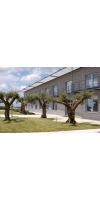Wine from Tamara

The Tamara Estate
Joao Portugal Ramos has been connected to Portuguese wines for more than 20 years, first as a consultant oenologist of well known wines, and since 1992, as a producer.
Alentejo was the region elected to produce his first wines, such as the Marques de Borba, Vila Santa, various Single Varieties, Quinta da Viçosa and Loios.
Afterwards, Ribatejo came along and the main objective was to highlight the wines from this region and make them better known worldwide.
The facility was renovated in 2004 with new wine making and bottling premises in Almeirim (Ribatejo) using the most sophisticated and modern equipment that now allows Falua to produce 1.5 million bottles of red, white and rosé wines of high quality.
The new striking metallic edifice enhances the modernity of the winery and makes Falua stand out from the other more traditional wineries of the area.
The oenologist for Tamara Red is Antonina Barbosa.
The Tamara Vineyard
The grapes come from Ribatejo, in East Central Portugal, along the Tajus river and are grown in sandy soil.
Ribatejo (called Tejo since 2009) is located in the north of Lisbon, with low hills surrounding the Tagus River. Ribatejo is divided into three sub-regions with different characteristics:
- “Campo”: marshy land alongside the river
- “Bairro”: on the right bank of the Tagus River, slightly higher elevation
- “Charneca”: stretches from the Tagus right bank to the Alentejo region.
Vines are grown in all three regions. Falua vines come mainly from “Charneca” that provides with the most favorable soils.
The three different regions “Charneca”, “Bairro” and “Campo” have specific characteristics in the composition of their soils that vary between alluvial, clay and sandy.
They own 100 hectares of vineyards planted with the following varieties: Arinto, Castelão, Trincadeira, Aragonês, Syrah, Alicante Bouschet, Cabernet Sauvignon, Touriga Nacional, Touriga Franca, Fernão Pires and Chardonnay.
The climate is mild Mediterranean, and thanks to the proximity of the river, it is characterized by winters with compacted rainfall and dry warm summers.
The average summer temperature runs between 20 and 35ºC.
The insulation varies between 2700 and 2900 hours per year and the rainfall between 600 and 800 mm.
No products found
- back
Selected Options
Wineries
Categories
Pricing
Countries
Regions
Grape Types
Wineries
Organic/Free Shipping
Mollydooker Velvet Glove Shiraz is made from 100 percent Shiraz.
Sticky plum jam and spicy nutmeg aromas are alluringly prominent on the nose, whilst berries and mocha weave
and envelop your entire palate. The finish is incredibly smooth and silky, with elegant fruit flavors that linger in your mouth. An outstanding example of a perfectly balanced Shiraz from McLaren Vale.
Review:
The dazzling 2021 ‘The Velvet Glove’ is a monumental effort that has some really great aging potential. Coming from the Gateway Vineyard in McLaren Vale, this was aged in all new American oak before bottling. A total stunner, the seamless texture entices as you are greeted to blueberry compote with creme de violette, asphalt and stony mineral flavors, with serious viscosity and tension. This was just as outstanding tried the day after opening. Very heady and hedonistic, yet showing an astonishingly good acid backbone, this beauty will live on for another fifteen plus years to come.
- Owen Bargreen 99 Points
Boira' Pinot Grigio is made from certified organically farmed vineyards surrounding the city of Verona.
The wine shows a brilliant straw color with golden reflections. Fresh and floral bouquet with a hint of pears, apricots and bananas blended with intense aromas of acacia flowers. Fresh and inviting on the palate with bright fruit and an easy drinking style with a pleasing hint of almonds in the aftertaste.
The average age of the vines is 25 years old. The vineyards' soils are made of stoney calcareous, rich in minerals and fossils that gives this wine bright aromatics and a refreshing lift on the palate. After a 12-hour skin maceration to obtain enhanced aromas, the wine is fermented in stainless steel. The finished wine is placed in stainless steel holding tanks until bottled. Aged 3-4 months in stainless steel.
Pairs well with seafood dishes.




